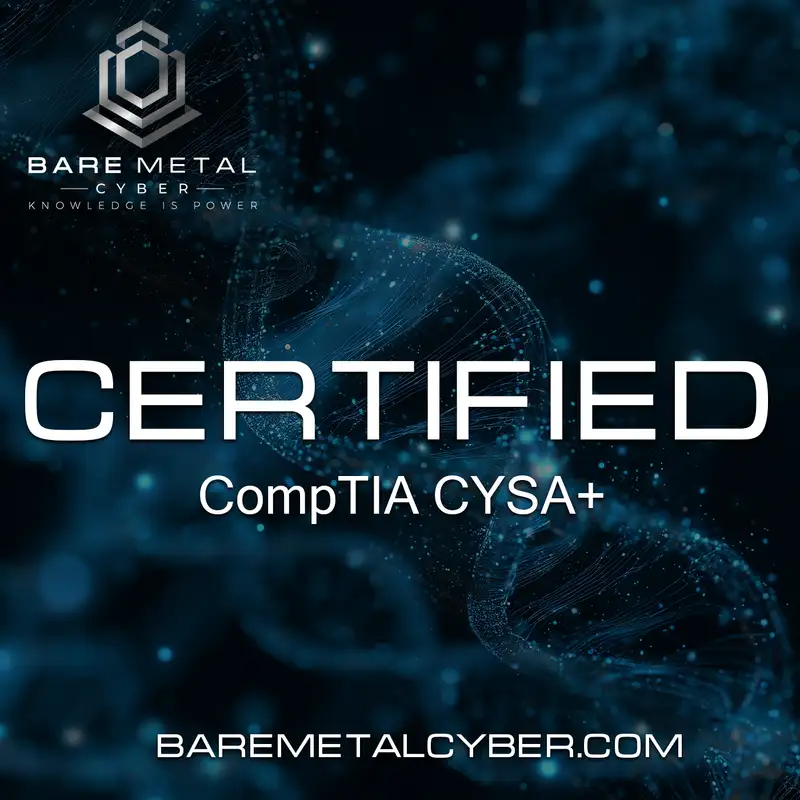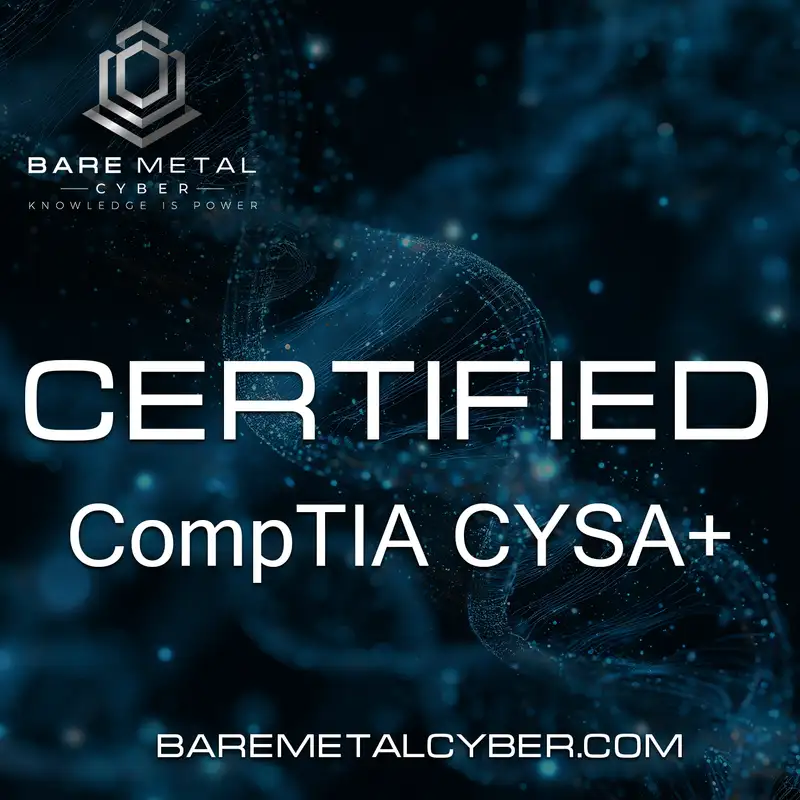Episode 5: What to Expect on Exam Day: Questions, Time, and Tips
Episode 5: What to Expect on Exam Day — Questions, Time, and Tips
Welcome back to your CYSA Plus Prep cast. In Episode Five, we’re going to focus on the moment of truth—exam day. This episode is designed to prepare you for what you’ll face during your actual CYSA Plus exam session. We'll break down the structure of the test, walk through the types of questions you'll encounter, discuss the timing and pacing strategy, and share important techniques to help you remain calm and collected. Being mentally and logistically prepared can dramatically improve your performance when it matters most.
When exam day arrives, you'll sit for the CYSA Plus CS Zero Dash Zero Zero Three exam, which includes a total of up to eighty-five questions. These questions are a combination of traditional multiple-choice formats and performance-based scenarios. The goal of this dual structure is to evaluate both your theoretical knowledge and your practical ability to detect, analyze, and respond to cybersecurity threats. You are expected to move fluidly between knowledge recall and hands-on problem solving throughout the exam.
The multiple-choice questions you'll face are not simple trivia. Most of them are scenario-driven, which means you’ll be asked to read a paragraph or interpret a situation before selecting the best or most appropriate option. These questions often come with four or five choices that may all seem plausible at first glance. Success here requires more than memorization—it demands attention to detail, critical thinking, and the ability to identify subtle cues hidden in the phrasing of the question or the context of the scenario.
A significant portion of your exam will consist of performance-based questions, or PBQs. These are interactive exercises that ask you to apply your skills in simulated environments. You may be required to analyze log files, configure firewall rules, perform vulnerability scans, or make decisions about how to respond to a security breach. These questions are designed to test your ability to perform the job functions of a real cybersecurity analyst. The practical, scenario-based nature of these tasks sets CYSA Plus apart from many other certifications that rely mostly on theoretical understanding.
Performance-based questions vary in length and complexity. You might be asked to drag and drop configuration settings, review logs for signs of malicious activity, or select a series of actions based on a sequence of events. These questions typically do not include partial credit, and they are intended to simulate realistic cybersecurity scenarios. That means you need to be comfortable applying concepts rather than simply recalling definitions. During your study, try to focus on lab work and hands-on practice that mirrors these types of exercises.
The total exam time is one hundred sixty-five minutes—just under three hours. This is a generous window, but only if you manage your time wisely. Many candidates find the performance-based questions to be the most time-consuming. These scenarios may take up to ten or even fifteen minutes each, depending on their complexity. In contrast, multiple-choice questions should generally take between one and two minutes. Having a plan for how you’ll allocate your time ensures you don’t run out of it in the final stretch of the exam.
Proper pacing can be the difference between passing and failing. As a guideline, aim to complete the multiple-choice questions within the first hour and a half, leaving yourself extra time to handle the performance-based questions and to revisit any flagged items. Start the exam by scanning through the questions quickly. If a performance-based question appears early and seems overly complex, don’t hesitate to skip it and return later. Getting stuck early can drain your time and impact your confidence for the remainder of the exam.
CompTIA exams allow you to mark questions for review. This feature is extremely helpful, especially when you encounter items that seem confusing or when you’re unsure about your answer. Use the mark-for-review function to flag those questions, move on, and return to them once you’ve answered the rest. Often, another question later in the test may trigger your memory or provide context that helps you resolve an earlier item. Just remember to revisit all flagged questions before time expires to ensure you don’t leave anything unanswered.
Whether you choose to take the exam in person at a testing center or through an online proctored format, expect a highly controlled environment. At in-person locations, you’ll be required to present valid identification, follow strict procedures, and store all personal items in a secure locker. The remote testing format also includes detailed pre-checks such as room scans, webcam monitoring, and ID verification. Make sure you read through all testing procedures in advance to avoid surprises or delays on the day of your exam.
On exam day, you're generally permitted to bring only your identification. Phones, bags, notes, and calculators are not allowed. For remote testing, you’ll need a quiet, distraction-free room and a stable internet connection. Before beginning, you’ll go through a check-in process that may include showing the room with your webcam and verifying that no other people or prohibited items are nearby. Preparing your space in advance prevents unnecessary stress and ensures you meet all exam integrity requirements.
Understanding and preparing for these exam-day logistics ahead of time ensures that your energy and attention are fully focused on answering questions, not managing complications. A smooth check-in process and clear awareness of the rules allow you to begin the test with confidence and peace of mind. Now that we’ve covered the technical and logistical structure, let’s explore some personal preparation strategies and mental habits that can help you maintain calm and clarity throughout the exam.
For more cyber related content and books, please check out cyber author dot me. Also, there are more security courses on Cybersecurity and more at Bare Metal Cyber dot com.
Before your official exam day, it’s extremely helpful to complete at least one or two full-length practice exams under realistic timed conditions. Doing so gives you a clearer sense of how to pace yourself, how long various question types take, and how fatigue may affect your focus over a three-hour period. These practice sessions allow you to experience the mental rhythm of the test and make adjustments to your strategy well before the stakes are real. Repetition under pressure builds familiarity, and familiarity reduces stress.
When your exam day finally arrives, whether you're taking the test in-person or online, make it a point to arrive early or log in at least fifteen minutes ahead of your scheduled time. This cushion helps you move through check-in procedures calmly, handle unexpected technical issues, and mentally settle in before the timer starts. Rushing at the beginning of the exam can carry over into your decision-making, leading to simple mistakes. A composed start gives you the mental space to concentrate fully from the very first question.
As you begin working through the exam, make it a habit to read each question thoroughly. Many CYSA Plus questions include subtle qualifiers or scenario details that are critical to selecting the correct answer. Key words such as “best,” “most appropriate,” or “first” can shift the meaning of a question significantly. In performance-based questions, it’s especially important to pause and confirm exactly what is being asked before attempting to solve the scenario. A quick read-through followed by a structured plan will prevent wasted effort and save time overall.
When faced with performance-based questions, the first step is to identify the goal of the task. Whether it’s interpreting logs, adjusting security settings, or prioritizing response steps, it’s easy to jump into action without clarity. Before you begin interacting with the simulation or providing answers, take a moment to outline a mental strategy. Decide what tools or information you’ll need to use, and approach the question systematically. A rushed or unstructured approach often results in incomplete or incorrect answers, especially when the scenario includes multiple steps.
It’s also helpful to trust your instincts when selecting answers. In many cases, your first choice is the result of your cumulative study and preparation. Unless a later realization gives you a clear reason to change an answer, resist the urge to second-guess yourself too frequently. Overthinking leads to wasted time and, in some cases, can actually reduce accuracy. This doesn’t mean ignoring your gut if something feels off, but rather maintaining confidence in your preparation and applying your knowledge with purpose.
Managing your stress level during the exam is as important as managing your time. Incorporate short pauses throughout the test to reset your focus. Every twenty or thirty minutes, take five to ten seconds to stop, breathe slowly, and clear your thoughts. Even just closing your eyes for a moment can lower anxiety and restore mental clarity. These small breaks can keep you mentally fresh and prevent your performance from declining due to stress or fatigue as the exam progresses.
If you feel yourself becoming overwhelmed at any point, remember that you are allowed to take a mental step back. It’s okay to close your eyes for a few seconds, breathe deeply, and return with a clearer head. A single stressful question shouldn’t derail your performance. By actively managing your mental state, you maintain your ability to reason logically and apply what you’ve studied. Practicing these techniques ahead of time, especially during your mock exams, makes them easier to use when you need them most.
Keep in mind that the exam does not penalize guesses. Unanswered questions are always marked incorrect, so if you’re running out of time or are truly unsure of an answer, always make an educated guess. Eliminate the clearly incorrect options first, then choose from the remaining ones. Statistically, a thoughtful guess has a much higher chance of being correct than leaving the question blank. Finishing all questions is crucial, and even a lucky guess can be the one that gets you to a passing score.
As the exam winds down, use any remaining time effectively. Revisit the questions you marked for review and take a fresh look at them. Sometimes stepping away and returning later allows you to see the correct answer more clearly. If time permits, double-check that your performance-based tasks are fully completed. It’s easy to overlook a final step or leave part of a simulation unfinished when you’re focused on managing the clock. These final minutes are your opportunity to improve your score and catch avoidable mistakes.
Once you complete the exam and submit your answers, you’ll receive preliminary results almost immediately on-screen. These results indicate whether you passed or failed, although your official detailed score report will arrive via email within forty-eight hours. This report breaks down your performance by domain, allowing you to see where you excelled and where you may need improvement if you plan to retake the test or pursue additional certifications. Regardless of the outcome, knowing how you performed in each area can help guide your future learning goals.
To wrap up this episode, successfully navigating exam day comes down to more than just knowledge. You also need to manage your environment, control your timing, and maintain a clear and composed mindset. By understanding the structure of the CYSA Plus exam, practicing with realistic simulations, and using proven test-taking techniques, you’ll maximize your chances of passing on your first attempt. Keep building your confidence and reinforcing your readiness—we’re here to guide you through every step on your journey to CYSA Plus certification. Stay tuned for more Prep cast episodes as we continue exploring the key skills and concepts you’ll need to master.

